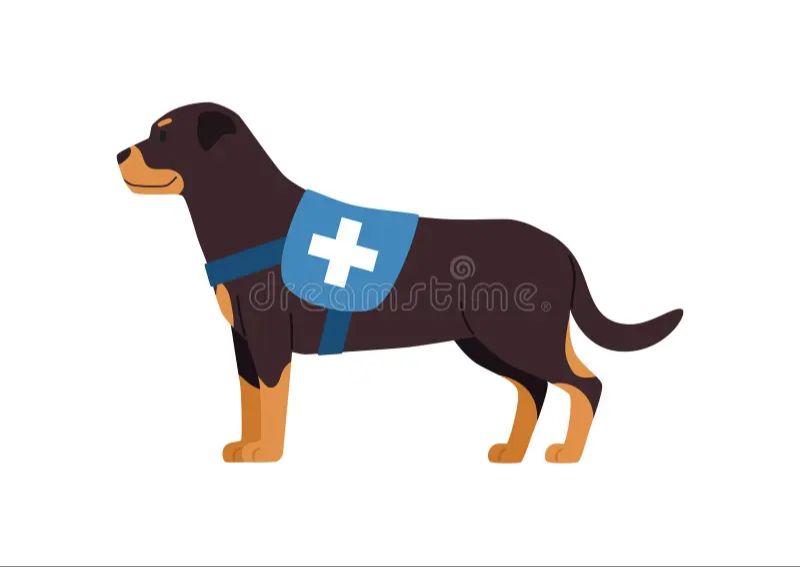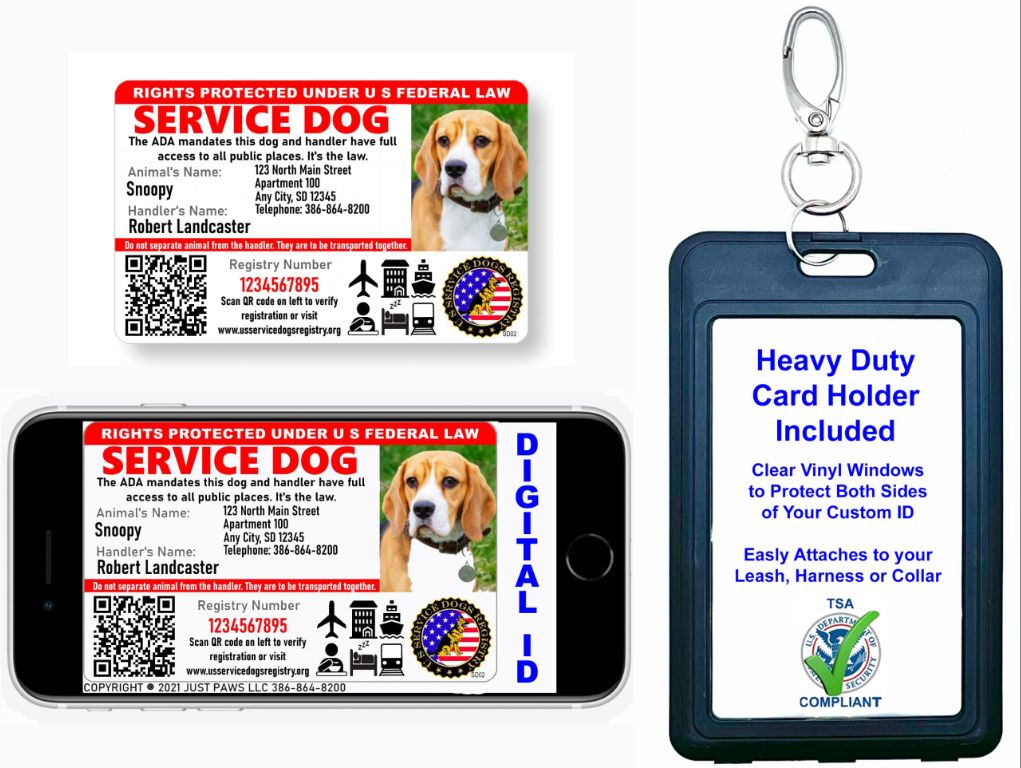Introduction
A service dog is a dog that is trained to perform tasks that assist people with disabilities. Service dogs can help with mobility, hearing impairments, seizures, anxiety and PTSD, and many other conditions. Under the Americans with Disabilities Act (ADA), service dogs are allowed public access rights to accompany their handlers to most places that the general public is allowed.
Service dogs often wear vests or harnesses to identify them as working dogs, not pets, and to prevent unnecessary interaction from the public. These vests come in a variety of colors that have different meanings. For example, orange often indicates a dog-in-training, red may indicate a medical alert dog, and purple can signify a disability is “invisible” or hidden like a psychiatric or neurological disability.
The purpose of a purple vest is to signify that the service dog is assisting someone with a hidden disability, one that may not be apparent to observers. The purple color helps create public awareness about disabilities that are not visible.
History of Service Dogs
The origins of service dogs for people with disabilities can be traced back centuries. There are records from ancient Rome that show dogs assisting people who were blind and disabled in the city of Herculaneum. In the 16th century in Europe, dogs were trained as guide dogs for the blind. And in the 18th century in China, small dogs were trained to alert their deaf owners of danger [1].
In the 1800s, more formal service dog training programs started emerging. In the 1920s, The Seeing Eye organization pioneered dog guide schools in the United States, training German Shepherds as guide dogs. Growth in service dog training programs expanded through the 20th century. The first service dogs trained to assist people with mobility impairments were introduced in the 1970s [2].
Vests for service dogs started being used in the late 1980s to help identify working dogs. The Americans with Disabilities Act, passed in 1990, legally recognized service dogs in the United States and established guidelines on public access rights [3].

Service Dog Laws
The Americans with Disabilities Act (ADA) provides federal protections for people with disabilities who utilize service dogs. Under the ADA, businesses and organizations that serve the public must allow service dogs to accompany their handlers. The ADA defines a service animal as “any dog that is individually trained to do work or perform tasks for the benefit of an individual with a disability.”
Some key aspects of ADA service dog laws include:
- Service dogs are allowed in public places and businesses where pet dogs are not typically allowed.
- Service dog handlers cannot be charged extra fees or deposits.
- If a service dog behaves poorly and poses a threat, the handler can be asked to remove it.
- The ADA does not require proof of certification or ID cards for service dogs.
While the ADA provides federal protections, individual states can expand laws related to service dogs but cannot diminish ADA rights. Some states have additional laws allowing service dogs in training the same access rights as fully trained service dogs. Many states have laws penalizing discrimination against service dog users or misrepresenting a pet as a service animal.
Laws related to service dogs vary significantly by state. For example, Taking a Service Animal to Work notes that some states allow employers to ask for documentation showing the need for a service dog.
Purpose of Vests
Service dog vests serve two main purposes: to clearly identify the dog as a service animal, and to avoid issues with public access. According to Working Service Dog, service dogs are not required by the ADA to wear any identification or gear. However, a vest that says “service dog” makes it easy for businesses and the public to recognize the dog’s status.
This identification can prevent misunderstandings or access issues. The vest signals to others that this is not just a pet, but a working service dog that is allowed public access rights under the ADA. It helps minimize disruptions for the handler and avoids situations where the dog’s access may be challenged. Though not mandatory, a service dog vest can make life easier for both the dog and handler.
Common Vest Colors
Service dog vests come in a variety of colors, each with their own specific meaning:
Red – Means “stop,” indicating not to distract or interact with the dog as they are actively working. The red vest signals that the service dog should not be petted or played with.

Orange – Signifies a dog “in training.” The orange vest indicates that the service dog is still learning and may not be fully task trained yet, so extra patience and space should be given.
Blue – Denotes a “calm” dog. The blue vest is sometimes used for dogs that may be anxious around crowds or stressful situations. It asks others to allow extra distance so the dog can focus.
Yellow/Green – Warns “do not separate from handler.” These bright vest colors indicate that the service dog should not be separated from their handler under any circumstances.
Significance of Purple Vest
A purple vest on a service dog indicates that the dog assists someone with psychiatric disabilities, anxiety disorders, PTSD, or other similar invisible disabilities. The purple color helps signify to the public that the dog has special training to support a person with a non-physical disability.
According to Cuteness, purple vests help increase public awareness and acceptance of service dogs for mental health conditions. Many traditional service vests are red or blue, but a purple vest clearly communicates the dog’s specific purpose in aiding anxiety, PTSD, or other challenges that may not have obvious external symptoms.
The purple color is thought to have a calming effect and symbolizes wisdom, dignity, independence, creativity, and imagination. For those with psychiatric disabilities like depression or PTSD, having their specially trained service dog visibly identified by a purple vest can help maximize the sense of security, stability, and independence the dog provides.
Types of Hidden Disabilities
Psychiatric service dogs can help people with a variety of mental health conditions, including post-traumatic stress disorder (PTSD), anxiety, depression, schizophrenia, bipolar disorder, and more. These are considered “hidden disabilities” because they may not be outwardly apparent, yet they significantly impact daily functioning and quality of life.
For people with PTSD, a service dog can help ease anxiety and provide a sense of security in situations that trigger symptoms. The dog is trained to do things like create a physical barrier between the handler and strangers in crowded places or repeatedly nudge the handler to disrupt dissociative episodes associated with PTSD flashbacks. This can help the individual remain grounded in the present moment.

Service dogs for anxiety may be trained similarly to interrupt panic attacks and repetitive behaviors. Applying deep pressure therapy, reminding the handler to take medication, and even dialing 911 during a mental health crisis are also helpful service dog tasks. These functions provide critical support that improves daily stability.
Those struggling with depression may benefit from a service dog that motivates them to engage in self-care and provides unconditional affection and companionship. Having a reason to get out of bed and maintain a schedule aids some people suffering from severe depression. Additionally, psychiatric service dogs help combat feelings of isolation and loneliness associated with the condition.
Service Dog Etiquette
When encountering a service dog in public, it is important to follow proper etiquette and respect the dog’s role as a working animal. The most critical rule is to not distract or touch a service dog without the owner’s permission. This includes staring, making noises, trying to feed, or attempting to pet the dog. Doing so can jeopardize the safety of the handler if it causes the dog’s attention to waver from its responsibilities.
According to the article “The Rule for Service Dogs: Don’t Touch or Distract Them” on the PawsofWar.org website, “Whether the dog is in service or in training to serve, the rule of thumb is: don’t touch or distract him. This is because interacting with a dog that is working prevents them from doing what they’ve been trained to do.” Distracting a service dog risks the independence of disabled handlers who rely on them.
It is also proper etiquette to give right of way to a service dog and its handler in public, such as holding doors open for them or allowing them to board elevators first. The focus should be on assisting the handler if needed, not interacting with the dog.
Service Dog Credentials
There are no federally mandated credentials required for service dogs under the Americans with Disabilities Act (ADA). The ADA does not require service dogs to be certified, registered, or professionally trained. https://www.ada.gov/service_animals_2010.htm
However, many service dog owners choose to obtain credentials like IDs, certification, or registration on their own. These credentials are provided by private organizations to help identify a dog as a service animal. They can make public access easier by avoiding questions about the dog’s status. Some common credentials include:https://www.servicedogcertifications.org/
- Photo ID cards
- Certificates
- Vests
- Collars
- Leashes

It’s important to note these credentials are optional and not legally required. Service dog owners are not obligated to show any credentials under the ADA. The legal test is whether the dog is individually trained to perform tasks for a person with a disability.
Conclusion
In summary, the color purple is significant for service dog vests, as it indicates the dog is assisting someone with a hidden disability. Purple brings awareness to disabilities that may not be visible, such as PTSD, anxiety, or diabetes. It reminds us not to make assumptions and that service dogs help people manage all kinds of challenges.
When interacting with service dogs, it’s essential we practice proper etiquette. Don’t distract or interact with a service dog when they’re working. Ask the handler first before petting. And remember, service dogs are highly trained medical equipment providing critical support. Show them respect, give them space, and don’t judge or question their legitimacy based on a vest color.
A service dog in a purple vest deserves the same access and protections as any other service animal. Their color doesn’t diminish their importance. With compassion and understanding, we can help make the world more inclusive for people with all types of disabilities and the dogs who assist them.
